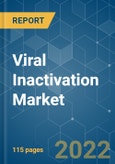The major factors attributing to the growth of the viral inactivation market are a rise in the global prevalence of chronic diseases like cancer, autoimmune disorders, and other diseases along with an increase in healthcare expenditure. For instance, in 2019, the American Cancer Society has reported that there would be 1,762,450 new cancer cases diagnosed and 606,880 cancer deaths in the United States which is expected to increase in the forecast period. Thus, due demand for the development of novel therapies is expected to drive the market during the forecast period.
Key Market Trends
Vaccines and Therapeutics Segment is Expected to Hold the Largest Market Share in the Viral Inactivation Market
Vaccines and Therapeutics segment is anticipated to hold the largest market share in the global viral inactivation market. The highest market revenue is due to higher incidences and huge economic burden of chronic diseases such as Cancer, that demanded the inactivated vaccines along with increasing government support for pharmaceutical and biotechnology industries to invest in R&D of novel therapeutics.
Also, the process of viral inactivation has been made mandatory step by regulatory authorities, such as the US Food and Drug Association (FDA) for investigational new drug (IND) submission in the view of safety concerns which contributes to the growth of the global viral inactivation market.
North America Dominates the Market and Expected to do Same in the Forecast Period.
North America is expected to dominate the overall, throughout the forecast period. In North America, the United States holds the largest market share in terms of revenue. Also, advanced healthcare infrastructure, the presence of major pharmaceutical and biopharmaceutical companies, and significant healthcare R&D expenditure by government and companies in the United States are the key factors estimated to fuel the market in North America.
Followed by North America, Europe accounts for the second-highest market share in the global viral inactivation market owing to the rapid R&D investments in the life sciences industry and new product launches in the region.
The Asia Pacific is set to grow at the fastest rate during the forecast period, driven by the developing healthcare infrastructure in emerging nations and rising awareness programs. Also, the ongoing trials in the region and rise in the prevalence of chronic diseases in emerging economies such as India and China will further stimulate the viral inactivation market growth in the region over the forecast period.
Competitive Landscape
The viral inactivation market is moderately consolidated, competitive and consists of several major players. In terms of market share, few of the major players are currently dominating the market with various development strategies. Some prominent players are making acquisitions and effective mergers to consolidate their market positions across the globe. Furthermore, new entrants are expected to enter the market with innovative product pipeline and continuous technological innovations that increase the market revenue over the forecast period.
Additional Benefits:
- The market estimate (ME) sheet in Excel format
- 3 months of analyst support
This product will be delivered within 2 business days.
Table of Contents
Companies Mentioned (Partial List)
A selection of companies mentioned in this report includes, but is not limited to:
- Merck KGaA
- Cytiva (Taleo)
- Sartorius AG
- Texcell SA
- Parker Hannifin Corp
- Vironova AB
- Viral Inactivated Plasma Systems SA
- Rad Source Technologies Inc
- Charles River Laboratories, Inc.
- WuXi PharmaTech
Methodology

LOADING...








